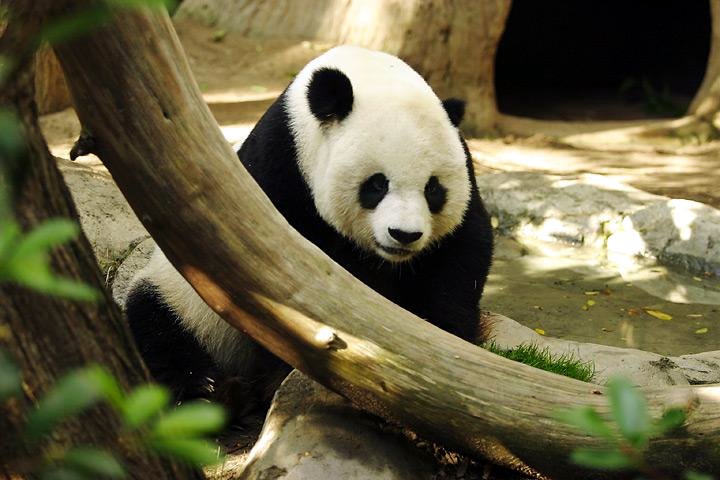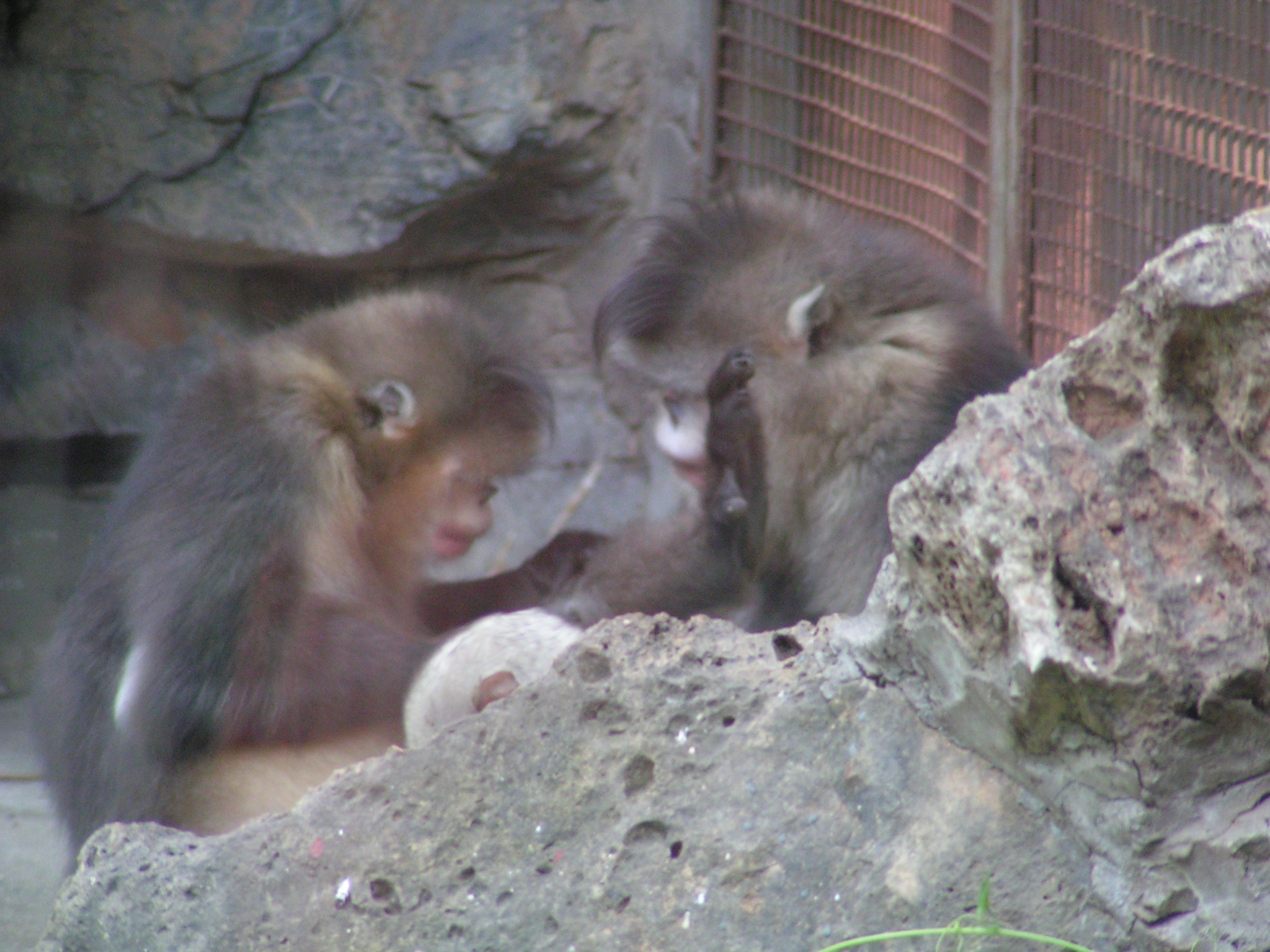|
Snub-nosed Monkey
__NOTOC__ Snub-nosed monkeys are a group of Old World monkeys and make up the entirety of the genus ''Rhinopithecus''. The genus is rare and not fully researched. Some taxonomists group snub-nosed monkeys together with the genus ''Pygathrix''. Snub-nosed monkeys live in Asia, with a range covering southern China (especially Tibet, Sichuan, Yunnan, and Guizhou) extending into the northern parts of Myanmar and Vietnam. These monkeys are named for the short stump of a nose on their round faces, with nostrils arranged forward. They have relatively multicolored and long fur, particularly at the shoulders and backs. They grow to a length of with a tail of . Snub-nosed monkeys inhabit mountain forests up to elevations of more than . In the winter, they move into the deeply secluded regions. Higher elevation areas are more remote and difficult for humans to access and utilize and other studies have found less deforestation, more reforestation and afforestation, less range contraction, a ... [...More Info...] [...Related Items...] OR: [Wikipedia] [Google] [Baidu] |
Golden Snub-nosed Monkey
The golden snub-nosed monkey (''Rhinopithecus roxellana'') is an Old World monkey in the subfamily Colobinae. It is endemic to a small area in temperate, mountainous forests of central and Southwest China. They inhabit these mountainous forests of Southwestern China at elevations of above sea level. The Chinese name is Sichuan golden hair monkey (四川金丝猴). It is also widely referred to as the Sichuan snub-nosed monkey. Of the three species of snub-nosed monkeys in China, the golden snub-nosed monkey is the most widely distributed throughout China. Snow occurs frequently within its range, and it can withstand colder average temperatures better than any other non-human primate. Its diet varies markedly with the seasons, but it is primarily a herbivore with lichens being its main food source. It is diurnal and largely arboreal, spending some 97% of its time in the canopy. There are three subspecies. Population estimates range from 8,000 to 15,000 and it is threatened by hab ... [...More Info...] [...Related Items...] OR: [Wikipedia] [Google] [Baidu] |
Reforestation
Reforestation (occasionally, reafforestation) is the natural or intentional restocking of existing forests and woodlands (forestation) that have been depleted, usually through deforestation, but also after clearcutting. Management A debated issue in managed reforestation is whether or not the succeeding forest will have the same biodiversity as the original forest. If the forest is replaced with only one species of tree and all other vegetation is prevented from growing back, a monoculture forest similar to agricultural crops would be the result. However, most reforestation involves the planting of different selections of seedlings taken from the area, often of multiple species. Another important factor is the natural regeneration of a wide variety of plant and animal species that can occur on a clear cut. In some areas the suppression of forest fires for hundreds of years has resulted in large single aged and single species forest stands. The logging of small clear cuts an ... [...More Info...] [...Related Items...] OR: [Wikipedia] [Google] [Baidu] |
Wildlife Of China
China's vast and diverse landscape is home to a profound variety and abundance of wildlife. As of one of 17 megadiverse countries in the world, China has, according to one measure, 7,516 species of vertebrates including 4,936 fish, 1,269 bird, 562 mammal, 403 reptile and 346 amphibian species. In terms of the number of species, China ranks third in the world in mammals,IUCN Initiatives – Mammals – Analysis of Data – Geographic Patterns 2012 IUCN. Retrieved 24 April 2013. Data does not include species in Taiwan. eighth in birds, seventh in reptiles and seventh in amphibians. [...More Info...] [...Related Items...] OR: [Wikipedia] [Google] [Baidu] |
American Journal Of Primatology
The ''American Journal of Primatology'' is a monthly peer-reviewed scientific journal and the official journal of the American Society of Primatologists. It was established in 1981 and covers all areas of primatology, including the behavioral ecology, conservation biology, evolutionary biology, life history, demography, paleontology, physiology, endocrinology, genetics, molecular genetics, and psychobiology of non-human primates. at wiley.com Besides its regular issues, the journal publishes a yearly supplementary issue detailing the program of the society's annual meetings. The is [...More Info...] [...Related Items...] OR: [Wikipedia] [Google] [Baidu] |
Myanmar Snub-nosed Monkey
The Myanmar snub-nosed monkey or Burmese snub-nosed monkey or black snub-nosed monkey (''Rhinopithecus strykeri'') is a critically endangered species of colobine monkey discovered in 2010 in northern Burma (Myanmar). It was formally described as a novel species of primate in 2011 based on its fur, beard and tail. Two groups of the species were discovered in China in 2011 and 2015, respectively. The species is known in local dialects of Lisu people as ''mey nwoah'' and Law Waw people as ''myuk na tok te'', both of which mean "monkey with an upturned face". Rain allegedly causes it to sneeze due to the short upturned nasal flesh around its nostrils. People from the area report that it sits with its head directed downwards, hiding its face between its knees when it rains. Discovery and taxonomy The Myanmar snub-nosed monkey was first discovered in 2010 from Gaoligong Mountains of northeastern Kachin state in Myanmar. The species came to the attention of a team of scientists ... [...More Info...] [...Related Items...] OR: [Wikipedia] [Google] [Baidu] |
Tonkin Snub-nosed Monkey
The Tonkin snub-nosed monkey or Dollman's snub-nosed monkey (''Rhinopithecus avunculus'') is a slender-bodied arboreal Old World monkey, endemic to northern Vietnam. It has black and white fur, a pink nose and lips, and blue patches around the eyes. It is found at elevations from on fragmentary patches of forest on craggy limestone areas. First described in 1912, the monkey was rediscovered in 1989 but is exceedingly rare. Out of the five snub-nosed monkey species in the world, the Tonkin snub-nosed monkey is the rarest. In 2008, fewer than 250 individuals were thought to exist, and the species was the subject of intense conservation effort. The main threats faced by these monkeys are habitat loss and hunting, and the International Union for Conservation of Nature has rated the species as " critically endangered". Description The Tonkin snub-nosed monkey has a flattened face with a pink upturned nose, thickened pink lips and areas of blue skin around its eyes. The upper parts are ... [...More Info...] [...Related Items...] OR: [Wikipedia] [Google] [Baidu] |
Gray Snub-nosed Monkey
The gray snub-nosed monkey (''Rhinopithecus brelichi''), also known as Brelich's snub-nosed monkey, Guizhou snub-nosed monkey, and Guizhou golden monkey, is a species of primate in the family Cercopithecidae. It is endemic to China, where it is known as the Guizhou golden hair monkey (黔金丝猴) or gray golden hair monkey (灰金丝猴). It is threatened by habitat loss. Of the three species of snub-nosed monkeys in China, the gray snub-nosed monkey is the most threatened, with a total population thought to number fewer than 400 individuals. Description Adults are covered with long, fine hair, generally grading from brown on its upper body to gray on its lower body, with a white patch between its shoulder blades. Its head, neck, and ends of its limbs are black, except for a golden brow. It has a golden chest, and chestnut fur on its inner knees and inner sides of its upper arms. Its face is bare bluish-white skin, pink around the eyes and mouth, and has a shelf-like brow and ... [...More Info...] [...Related Items...] OR: [Wikipedia] [Google] [Baidu] |
Black-and-white Snub-nosed Monkey
The black-and-white snub-nosed monkey (''Rhinopithecus bieti''), also known as the Yunnan snub-nosed monkey, is a large black and white primate that lives only in the southern Chinese province of Yunnan, where it is known to the locals as the Yunnan golden hair monkey (滇金丝猴) and the black-and-white snub-nosed monkey (黑白仰鼻猴). The common name, black snub-nosed monkey, is issued to ''Myanmar snub-nosed monkey, Rhinopithecus strykeri'', inhabiting the Northern Sino-Myanmar border. Coniferous and deciduous forests in the mountainous regions of Yunnan are the ideal terrain for these primates. It is threatened by habitat loss, and is considered an endangered species. With their unique adaptations to their environment, these monkeys thrive at extreme altitudes despite the below freezing temperatures and thin air. This primate's diet is mainly made up of the large amounts of lichens available in their region. Anatomy and physiology Male and female black-and-white snub-n ... [...More Info...] [...Related Items...] OR: [Wikipedia] [Google] [Baidu] |
Bamboo
Bamboos are a diverse group of evergreen perennial flowering plants making up the subfamily Bambusoideae of the grass family Poaceae. Giant bamboos are the largest members of the grass family. The origin of the word "bamboo" is uncertain, but it probably comes from the Dutch or Portuguese language, which originally borrowed it from Malay or Kannada. In bamboo, as in other grasses, the internodal regions of the stem are usually hollow and the vascular bundles in the cross-section are scattered throughout the stem instead of in a cylindrical arrangement. The dicotyledonous woody xylem is also absent. The absence of secondary growth wood causes the stems of monocots, including the palms and large bamboos, to be columnar rather than tapering. Bamboos include some of the fastest-growing plants in the world, due to a unique rhizome-dependent system. Certain species of bamboo can grow within a 24-hour period, at a rate of almost an hour (equivalent to 1 mm every 90 seco ... [...More Info...] [...Related Items...] OR: [Wikipedia] [Google] [Baidu] |
Endangered Species
An endangered species is a species that is very likely to become extinct in the near future, either worldwide or in a particular political jurisdiction. Endangered species may be at risk due to factors such as habitat loss, poaching and invasive species. The International Union for Conservation of Nature (IUCN) Red List lists the global conservation status of many species, and various other agencies assess the status of species within particular areas. Many nations have laws that protect conservation-reliant species which, for example, forbid hunting, restrict land development, or create protected areas. Some endangered species are the target of extensive conservation efforts such as captive breeding and habitat restoration. Human activity is a significant cause in causing some species to become endangered. Conservation status The conservation status of a species indicates the likelihood that it will become extinct. Multiple factors are considered when assessing the ... [...More Info...] [...Related Items...] OR: [Wikipedia] [Google] [Baidu] |
Black-and-white Snub-nosed Monkey
The black-and-white snub-nosed monkey (''Rhinopithecus bieti''), also known as the Yunnan snub-nosed monkey, is a large black and white primate that lives only in the southern Chinese province of Yunnan, where it is known to the locals as the Yunnan golden hair monkey (滇金丝猴) and the black-and-white snub-nosed monkey (黑白仰鼻猴). The common name, black snub-nosed monkey, is issued to ''Myanmar snub-nosed monkey, Rhinopithecus strykeri'', inhabiting the Northern Sino-Myanmar border. Coniferous and deciduous forests in the mountainous regions of Yunnan are the ideal terrain for these primates. It is threatened by habitat loss, and is considered an endangered species. With their unique adaptations to their environment, these monkeys thrive at extreme altitudes despite the below freezing temperatures and thin air. This primate's diet is mainly made up of the large amounts of lichens available in their region. Anatomy and physiology Male and female black-and-white snub-n ... [...More Info...] [...Related Items...] OR: [Wikipedia] [Google] [Baidu] |




